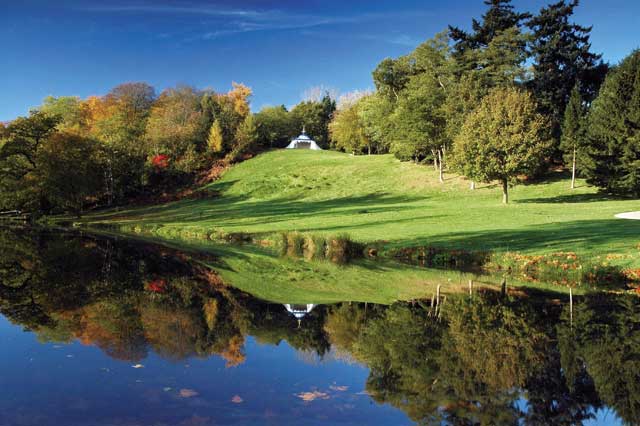Sleight of land: The creator of Painshill was a one-man expenses scandal
Luckily for visitors to this Surrey gem, his deceptions live on

Charles Hamilton is straight out of the expenses-scandal-hit class of MPs. The original designer of the garden at Painshill in Surrey, he used his networking skills to secure a series of easy, profitable government jobs, always aiming for cash to keep his elaborate garden going. His gothic temple, his water wheel, and his duck island were all funded by earnings from the public purse. (And when that wasn't enough, the Paymaster-General, a close pal, made him secret loans straight from government funds.)
But Hamilton missed out on the recent shamefacedness by several hundred years: he first took his seat in the House of Commons in 1727. "He does not appear to have devoted," remarks historian Michael Symes drily in an entertaining new book, Mr Hamilton's Elysium: The Gardens at Painshill (Frances Lincoln, £35) "any time to constituency duties." Well, how could he? He was too busy digging foundations, overseeing the planting of vineyards and tapping up friends for cash.
Despite these machinations, Symes makes it clear why a visitor might fall in love with Painshill. When Symes first saw it, the 18th-century garden in woodland (now just north of RHS Wisley) had been neglected for decades. "The Temple of Bacchus was propped up with a pole," he points out. By the 1970s, garden features were languishing in thick undergrowth. Local enthusiasts realised that time was running out, and managed to publicise its plight Nationwide. Eventually, funds were raised for the local council to purchase the land. Today, you would hardly know it had spent a moment uncared for. Glistening water, fine old trees, dramatic views, plus an award-winning visitor centre adds up to a delicious day out, especially in the winter, when the sky seems particularly blue reflected in the glassy lake.
It's even more wonderful when you realise how much of an illusion it all is. Symes is great on the detail of how the spectacle was constructed. That gothic temple, high on the hill? Plywood. That glistening grotto, with stone entrances piled high, and crystals hanging that sparkle as the water beneath them moves? Brick. And that Turkish tent, an exotic oriental motif on a distant hill? Partly papier-mâché. But the drama is real.
As are the wonderful plantings, which show off Hamilton's love for big trees and shrubs, newly discovered and imported from our American colonies. Swamp cypresses, turning deep-red in autumn, rare pines, spruces and magnolias; and some perfect American discoveries, such as the tulip tree, the Indian bean tree, and Liquidambar, the sweet gum. Read the book, take the walk, and marvel at how the world never really changes.
For more information: painshill.co.uk
More sleeping beauties
Painswick Rococo Garden, Cotswolds
Nothing was left of this prettiest of 18th-century gardens before a single painting offered all the clues for a full restoration. From 10 January, rococogarden.org.uk
Hestercombe, Devon
This garden had a former life as an elegant 18th-century landscape with temples, arbors and alcoves aplenty. Heritage Lottery funds of £3.7m are putting a spring back into its step. Santa is in the grotto (well, the Octagon Summer House) Wednesdays till Christmas. hestercombe.com
Lost Gardens of Heligan, Cornwall
Though tidier than when rediscovered, these gardens still weave their magic. Xmas lunch for £15, on selected dates. Open through winter, heligan.com
Subscribe to Independent Premium to bookmark this article
Want to bookmark your favourite articles and stories to read or reference later? Start your Independent Premium subscription today.

Join our commenting forum
Join thought-provoking conversations, follow other Independent readers and see their replies